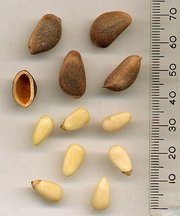Pine nuts are the edible seeds of pine trees (family Pinaceae, genus Pinus). About 20 species of pine produce seeds large enough to be worth harvesting; in other pines the seeds are also edible, but are too small to be of value as a human food.
In Europe, pine nuts come from the Stone Pine (Pinus pinea), which has been cultivated for the nuts for over 6,000 years, and harvested from wild trees for far longer. The Swiss Pine (Pinus cembra) is also used to a very small extent.
In Asia, two species are widely harvested, Korean Pine (Pinus koraiensis) in northeast Asia and Chilgoza Pine (Pinus gerardiana) in the western Himalaya. Four other species, Siberian Pine (Pinus sibirica), Siberian Dwarf Pine (Pinus pumila), Chinese White Pine (Pinus armandii) and Lacebark Pine (Pinus bungeana) are also used to a lesser extent.
In North America the main species are three of the pinyon pines, Colorado Pinyon (Pinus edulis), Single-leaf Pinyon (Pinus monophylla) and Mexican Pinyon (Pinus cembroides). The other eight pinyon species are used to a small extent, as are Gray Pine (Pinus sabineana), Torrey Pine (Pinus torreyana) and Sugar Pine (Pinus lambertiana).
Pine nuts are high in protein, and have been eaten in Europe and Asia since the Paleolithic period. They are also a source of dietary fibre. Pine nuts are an essential component of pesto, and are frequently added to meat, fish, and vegetable dishes. They are also used in chocolates and desserts such as baklava.
When first extracted from the pine cone, pine nuts are covered with a hard shell (seed coat), thin in some species, thick in others. The nutrition is stored in the large female gametophytic tissue that supports the developing embryo (sporophyte) in the centre. They are not a true nut as (being a gymnosperm) they lack a carpel (fruit) outside.
Unshelled pine nuts have a long shelf life if kept dry and refrigerated (at -5 to +2°C), but the shell must be removed before the nut is eaten; shelled nuts (and unshelled nuts in warm conditions) deteriorate rapidly, becoming rancid within a few weeks, or even days in warm humid conditions. Pine nuts are commercially available in shelled form, but due to poor storage, these rarely have a good flavour, all too often already being rancid before they are purchased. The most important species in international trade is Korean Pine, harvested in northeast China. In the United States, the pinyon pines have traditionally been the most highly sought after pine nuts.
Pine nuts are called piñones in Spanish and pinoli (locally also pinoccoli or pinocchi - Pinocchio means in fact 'pine nut') in Italian. In the US, they are also known as Indian nuts, as they are mainly harvested by Native American ("Red Indian") tribes; in many areas, they have exclusive rights to the harvest.
In the US, bad land use practices have led to the destruction of millions of hectares of productive pinyon pine woods by conversion to grazing lands, and in China, destructive harvesting techniques (breaking off whole branches to harvest the cones) and cutting of the trees for timber have led to losses in production capacity.
The large edible seeds of species of the Southern Hemisphere conifer genus Araucaria, notably the Monkey-puzzle (A. araucana) of Chile and the Bunya-bunya (A. bidwillii) of Australia, are also often called pine nuts.

